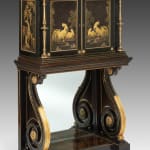Regency Cabinet with Japanese Lacquer Panels attributed to George Oakley
56 ½ x 35 ½ x 16 in
Further images
Provenance
Almost certainly supplied to Thomas, 2nd Marquess of Bath (1765-1837) for Longleat, Wiltshire and by descent at Longleat,Christie's, Furniture, Porcelain and Silver from Longleat; London, 13-14 June 2002, lot 326
with H. Blairman & Sons Ltd.
Private Collection
Literature
1837 Inventory, No. 59 Morning Room, 'One Ebony Cabinet with Folding doors and Looking Glass Back'.1869 Inventory, First Floor Corridor, 'An ebonised Cabinet with panels of Old Japan lacquer with domestic poultry in relief and ormolu columns on stand with looking glass back'.
1896 Inventory (2nd Marquess' Heirlooms), f 86 r Music Gallery, 'An ebonised cabinet with panels of old Japan lacquer with domestic poultry in relief and ormolu columns on stand with looking glass back - width 35 inches'.
H. Blairman & Sons Ltd., Regency Furniture & Works of Art, London 2020, cat. no. 3
The rectangular black slate top with a pierced gallery to the front and sides, above a breakfront frieze; the cabinet and base made of mahogany, ebonized mahogany and ebony; the two panelled doors decorated in mirror image with two cockerels and Regency period foliage, opening to reveal a shelf, flanked by turned columns, the sides decorated with weeping cherry blossom; the cabinet supported on a boldly scrolled stand with a mirrored back, raised on an inverted breakfront plinth base.
Designed in the French 'antiquarian' manner, this cabinet-on-stand reflects the influence of the Parisian marchands-merciers Dominique Daguerre and his successor Martin-Eloi Lignereux. The concept of combining 17th Century Japanese lacquer panels, embellished with European 'vernis' or over-decoration and employing them on a distinctly modern form was entirely the domain of the marchand-merciers in the strictly delineated French Guild system. Their pervasive influence, encouraged by the purchases made by George, Prince of Wales and, subsequently by his circle in Paris following the Treaty of Amiens in 1803 inevitably resulted in English cabinet-makers emulating this fashion.
Longleat House was decorated with hand-painted Chinese wallpaper in the 18th century and this cabinet was commissioned to complement the scheme. Two other pieces of furniture in the Christie’s sale of Furniture, Porcelain and Silver From Longleat 13–14 Jun 2002 were almost certainly made in the same workshop: lot 327 - a pair of dwarf bookcases and lot 328 - an 'antiquarian' secretaire cabinet which shares the black slate top, metalwork and the use of stained-sycamore to simulate ebony veneer are likely to be by George Oakley.
George Oakley (c. 1765-1841) was apprenticed to William Elliot, 2 St Clements Lane, London and in 1782 was recorded as an 'upholder' trading under his own name until 1789 at the same address. From 1798 he moved to 35 St Paul's Churchyard and had a fabric and wallpaper shop at No. 67 New Bond Street. Oakley was one of the pioneers of ‘buhl’ furniture and furniture in the Grecian taste around the turn of the 19th century. Queen Charlotte granted him a Royal Warrant following a visit in 1799. In 1801 the London correspondent on the ‘Journal de Luxus und der Moden’ (Weimar) wrote 'all people with taste buy their furniture at Oakley's, the most tasteful of the London cabinet makers'. (See M. Jourdain and R. Edwards, Georgian Cabinet Makers, London 1944, p.74). Oakley’s most prestigious commissions included work for the Prince Regent at Carlton House, the Mansion House and the Bank of England, John Madryll Cheere in 1809 for Papworth Hall, Cambridgeshire and James Henry Leigh between 1813-1819 for Stoneleigh Abbey, Warwickshire. He also worked with other prestigious furniture makers Thomas Shackleton and Henry Kettle, the latter having created furniture for Saltram, Devon.










